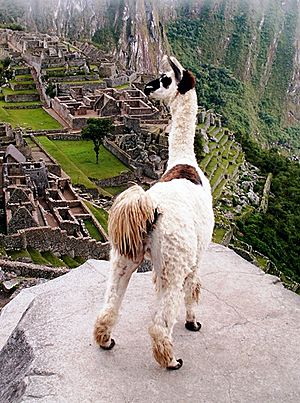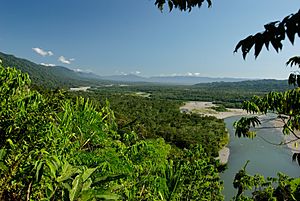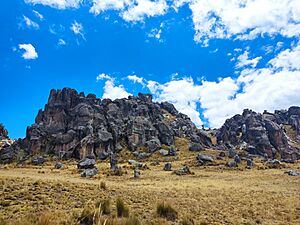Wildlife of Peru facts for kids
Peru is a country with amazing biodiversity, meaning it has a huge variety of plants and animals. It's one of the few "mega diverse" countries in the world. This is because Peru has the tall Andes mountains, the vast Amazon rainforest, and the long Pacific Ocean coastline. Peru has the fourth-largest amount of tropical forests and the ninth-largest forest area globally. Many studies show that Peru is among the top five countries for biodiversity.
Contents
Protecting Peru's Nature
The government of Peru knows how important its natural treasures are. In 1993, the country's Constitution said that Peru's natural resources and ecosystems are part of its heritage. Later, in 1999, the National System of Natural Areas Protected by the State (called SINANPE) was created. This system helps manage and protect these special places. It's run by the National Service of Natural Protected Areas by the State (SERNANP). They also made a map to show where these important natural and historical places are.
Peru has 76 natural protected areas. These areas cover more than 15% of the country! The national government protects them. They include 15 national parks, 9 national sanctuaries, 4 historical sanctuaries, and many other types of protected lands.
National Parks: Wild Places to Explore
National parks are special places set aside to protect wildlife and beautiful scenery. In these parks, people are not allowed to use natural resources or build homes. This helps keep nature safe.
The oldest national park in Peru is Cutervo. It was created in 1961 in the Cajamarca region. Cutervo is famous for its many caves, like San Andrés Cave. These caves are home to the oilbird, a nocturnal bird that is in danger of disappearing.
Other important national parks include:
- Tingo María (in Huánuco): Known for the Cave of the Owls, also home to oilbirds.
- Manu (in Madre de Dios and Cusco): One of the best places to see Amazonian biodiversity. It's recognized by UNESCO as a Natural World Heritage Site.
- Huascarán (in Áncash): Dominated by Mount Huascarán, Peru's highest mountain. It's home to the giant Puya raimondii plant and many animals.
- Cerros de Amotape (in Piura and Tumbes): Known for its dry forests and endangered animals like the Tumbes crocodile.
- Río Abiseo (in San Martín): Also a UNESCO Natural and Cultural World Heritage site.
- Yanachaga-Chemillén (in Pasco): Protects tropical forests and important old archaeological sites.
- Bahuaja-Sonene (in Madre de Dios and Puno): Includes tropical forests and the Heath pampas.
National Reserves: Protecting Animals and Plants
National reserves are areas created to protect and help wildlife grow. Here are some of the most important ones:
- Pampa Galeras-Bárbara D’Achille (in Ayacucho): Dedicated to protecting the vicuña, a wild relative of the llama.
- Junín (in Junín): Protects the ecosystem and biodiversity of Lake Junín.
- Paracas (in Ica): Focuses on saving marine animals and cultural history.
- Lachay (in Lima): Aims to restore and protect the ecosystem of the Lachay hill.
- Pacaya-Samiria (in Loreto): Protects lowland forest ecosystems and supports local people.
- Salinas y Aguada Blanca (in Arequipa and Moquegua): For protecting plants, animals, and beautiful landscapes.
- Calipuy (in La Libertad): Focused on protecting guanacos, another relative of the llama.
- Titicaca (in Puno): Dedicated to protecting the ecosystems and landscapes of Lake Titicaca.
Other Protected Areas
Besides national parks and reserves, Peru has many other types of protected areas. These include:
- National sanctuaries like Huayllay and Machu Picchu.
- Historical sanctuaries that protect important historical sites.
- National forests and protection forests that keep large forest areas safe.
- Communal reserves and hunting reserves.
- Reserved zones like Tambopata-Candamo.
All these different protected areas show how incredibly rich Peru is in nature and history. This makes Peru one of the most special natural regions in the world!
Amazing Animals of Peru
Peru is home to an incredible number of animals! It has over 1,800 different kinds of birds, with 120 of them found only in Peru. There are also more than 500 types of mammals and over 300 types of reptiles.
Peru's Pacific Ocean is full of sea life. You can find sea bass, flounder, anchovies, tuna, crustaceans like crabs and lobsters, and shellfish. There are also seals, sharks, and even whales! The birds of Peru are also very important. Their droppings, called guano, are collected and sold to other countries as fertilizer. The Alpaca, known for its soft fiber, is also native to Peru and has been domesticated.
Mammals: From Jaguars to Rare Rodents
Peru has over 500 species of mammals. About 70 of these are found only in Peru, and around 109 are threatened or endangered. Some amazing mammals include the powerful jaguar and the unique spectacled bear. There are also rare species like the yellow-tailed woolly monkey.
Scientists are still discovering new mammals in Peru. For example, in 2007, they found a new type of cloud-forest rodent called a spiny rat (Isothrix barbarabrownae) in the Manu area. In 2009, a new species of mouse (Akodon sp.nov) was also discovered.
Birds: A Feathered Paradise
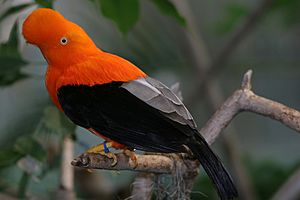
Peru's national bird is the colorful Andean cock-of-the-rock.
Peru has more than 1,800 species of birds, which is the second-highest number in the world! Scientists are still finding and cataloging new bird species. In the last 30 years, 42 new bird species from Peru have been officially added to science. In 2010, scientists even found a new group of five long-whiskered owlets, which are very rare.
The Manu Biosphere Reserve is thought to have the highest number of bird species anywhere. It has about 1,000 different kinds of birds – that's one out of every nine bird species on Earth!
Reptiles: Snakes, Lizards, and Turtles
Peru is home to about 300 species of reptiles, with around 100 of them found only there. Peru's reptiles include impressive creatures like giant anacondas and caimans. You can also find many other types of snakes, lizards, and turtles.
Amphibians: Frogs and Salamanders
There are about 380 species of frogs in Peru. If you go on night hikes in the lowland rainforests, you can often spot a few different kinds. Scientists have discovered ten new frog species in the cloud forests of the Peruvian Andes in just the last two years.
Frogs of Peru
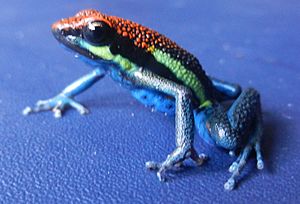
Some interesting frog species found in Peru are:
- Monkey frog - Phyllomedusa bicolor
- Tree frog - Dendropsophus rhodopeplus
- Three-striped poison dart frog - Epipedobates trivittatus
Salamanders of Peru
- Nauta mushroomtongue salamander - Bolitoglossa altamazonica
- Rio Santa Rosa salamander - Bolitoglossa digitigrada
- Peru mushroomtongue salamander - Bolitoglossa peruviana
In 2009, scientists found a tiny pygmy frog. This frog is special because its eggs don't turn into tadpoles like most frogs. Instead, they hatch directly into tiny frogs! They also only lay two eggs at a time.
Plants: Diverse Flora of Peru
Peru also has an amazing variety of plants. The coast of Peru is usually dry, with mostly cacti growing there. Hilly areas called lomas, like Lachay, have many plant species found nowhere else. River valleys also have unique plant life.
High in the Andes, above the tree line, is an area called puna. Here, you'll find bushes, cactus, and plants that can survive dry conditions, like ichu grass. These plants grow up to the snowy mountain peaks. The most spectacular plant in Peru is the giant Puya raimondii, which can be seen near Huaraz. On the lower slopes of the Andes, there are steep cloud-forests. These wet forests are full of moss, beautiful orchids, and bromeliads. The very wet Amazon rainforest has useful timber, resins, and many strange canopy plants and palm trees.
In 2009, scientists discovered a new plant called Senecio sanmarcosensis. This plant is part of the high-Andean wetlands vegetation and is only found at about 14,764 feet (4,500 meters) above sea level.
Great Places to See Wildlife in Peru
Peru has many fantastic places to observe its incredible wildlife:
- Bahuaja-Sonene National Park
- Ballestas Islands (Islas Ballestas)
- Colca Canyon
- Huascarán National Park: This park is in central Peru and includes El Huascarán, the country's highest peak. You might see spectacled bears and vicuñas here.
- Iquitos
- Manu National Park: Located on the eastern slopes of the Andes, stretching into the Amazon rainforest.
- Pacaya-Samiria National Reserve: Found in the Amazon River's headwaters in northeastern Peru. It's one of the best places for spotting wildlife and is the largest protected area in the Amazon rainforest that floods.
- Pampa Galeras National Reserve.
See also
 In Spanish: Fauna del Perú para niños
In Spanish: Fauna del Perú para niños
- List of Peruvian monkey species


